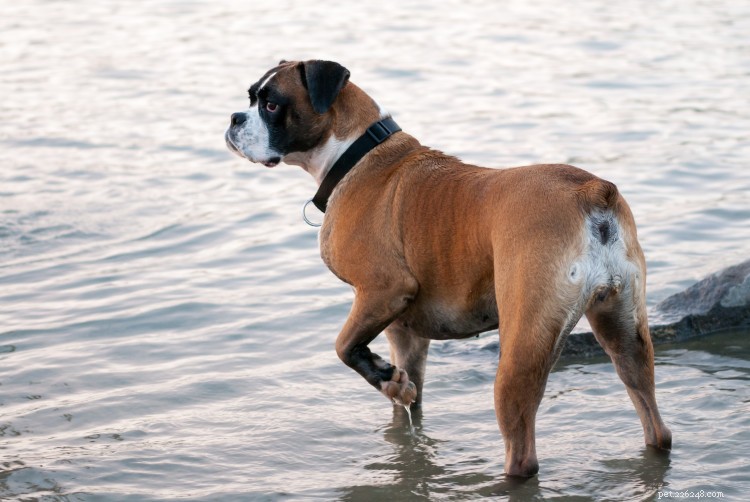Tabela de crescimento e peso de boxeadores:tudo o que você precisa saber
Boxers são cães divertidos, leais e alertas com uma constituição atlética. Criado originalmente para caça de grande porte, o Boxer é considerado um cão de médio a grande porte. Eles são excelentes com crianças e cães de guarda astutos. Hoje, eles são conhecidos por serem uma das dez raças de cães mais populares da América e por terem a língua mais longa entre os cães. Se você tem um filhote de Boxer, pode estar se perguntando qual o tamanho que um Boxer pode crescer e como sei que meu Boxer terminou de crescer?
Tudo o que você precisa saber sobre o crescimento do Boxer:
- Tabela de crescimento e peso de boxeadores masculinos
- Tabela de crescimento e peso de pugilistas femininas
- Com que idade um Boxer é adulto?
- Qual é o tamanho de um Boxer de 6 meses?
- Qual será o tamanho do meu Boxer?
- Qual é o tamanho de um Boxer adulto?
- Como posso ter certeza de que meu Boxer está saudável?
Tabela de crescimento e peso do boxeador
Os números a seguir são todos estimativas para ajudá-lo a estimar o tamanho do seu Boxer em determinadas idades. Essas são estimativas, então não se preocupe se o seu Boxer estiver um pouco atrás ou à frente desses números. Simplesmente continue levando seu Boxer a consultas veterinárias regulares para garantir que ele esteja feliz e saudável.
Dica profissional: Quer ser reembolsado pelas contas do veterinário do seu cão? Compare as opções de seguro de saúde Boxer e inscreva-se para economizar muito nos custos do veterinário (e tranqüilidade).
Tabela de crescimento e peso de boxeadores masculinos
| Idade | Peso |
|---|---|
| 1 mês | 5,5 - 9 libras |
| 2 meses | 16 - 20 libras |
| 3 meses | 22 - 26 libras |
| 4 meses | 30 - 35 libras |
| 5 meses | 35 - 41 libras |
| 6 meses | 41 - 48 libras |
| 7 meses | 48 - 55 libras |
| 8 meses | 50 - 57 libras |
| 9 meses | 52 - 61 libras |
| 10 meses | 55 - 63 libras |
| 11 meses | 57 - 66 libras |
| 1 ano | 57 - 68 libras |
| 1,5 anos | 60 - 70 libras |
| 2 anos | 60 - 70 libras |
Tabela de crescimento e peso de pugilistas femininas
| Idade | Peso |
|---|---|
| 1 mês | 4,5 - 8 libras |
| 2 meses | 11 - 17 libras |
| 3 meses | 22 - 26 libras |
| 4 meses | 28 - 30 libras |
| 5 meses | 33 - 37 libras |
| 6 meses | 39 - 44 libras |
| 7 meses | 44 - 50 libras |
| 8 meses | 50 - 52 libras |
| 9 meses | 52 - 59 libras |
| 10 meses | 52 - 59 libras |
| 11 meses | 52 - 59 libras |
| 1 ano | 52 - 61 libras |
| 1,5 anos | 55 - 63 libras |
| 2 anos | 55 - 65 libras |
Com que idade um Boxer é adulto?
Como uma raça de cães de médio a grande porte, os Boxers precisam de mais tempo para preencher e atingir seu tamanho total do que as raças de cães menores. Como regra geral, espere que seu Boxer cresça até os 18 a 24 meses de idade. Lembre-se de que esse intervalo é uma estimativa, portanto, sempre há exceções.
 (Fonte da imagem:Canva)
(Fonte da imagem:Canva) Qual deve ser o tamanho de um Boxer de 6 meses?
Um Boxer macho de 6 meses deve pesar cerca de 41 a 48 libras, enquanto uma Boxer fêmea de 6 meses pesará cerca de 39 a 44 libras.
De acordo com Care.com, os filhotes atingem cerca de 75% de sua altura total aos seis meses de idade. Para um filhote de Boxer macho, isso seria em torno de 17 a 19 polegadas de altura. Filhotes Boxer fêmeas de 6 meses de idade terão aproximadamente 16 a 18 polegadas de altura.
Dica profissional: Confira esta nova lista de verificação de filhotes para download, abrangendo tópicos como cronogramas de vacinação, preparação da casa para um novo filhote, dentição, visitas ao veterinário e muito mais!
Qual será o tamanho do meu Boxer?
There are several ways to estimate how much bigger your Boxer will grow.
If your Boxer is less than two years old , they are likely still growing. Some Boxers stop growing closer to 18 months, but many Boxers will continue to fill out in weight and body size until they are two years old.
Another possible way to estimate their size is to contact your Boxer’s breeder . Many breeders can give you a more accurate estimate based on previous litters and their parents’ exact height and weight. A puppy will rarely be larger than either parent, so this can give you a clearer idea of their maximum size.
Lastly, take a look at your Boxer’s paws . Do their paws look oversized compared to their legs and the rest of their body? This is a strong sign that your Boxer is still growing and filling out!
What is the size of a full-grown Boxer?
According to the American Kennel Club Official Boxer Standards, a full-grown male Boxer will stand around 23 to 25 inches tall, while a female Boxer will stand about 21.5 to 23.5 inches tall.A fully grown male Boxer will weigh around 60 to 70 pounds, with their female counterpart will weigh about 55 to 65 pounds.
 (Image Source:Pexels)
(Image Source:Pexels) How do I make sure my Boxer is healthy?
As with many things, prevention is always better than treatment. Taking your Boxer to regular veterinary appointments is one of the best things you can do for their health, along with consistent love and care at home.
One of the best things you can do at home is brush your dog's teeth regularly to help prevent painful periodontal disease and avoid pricey dental treatments in the future. Periodontal disease can cause bad breath and oral pain for your pup and may require your Boxer to have a dental cleaning or tooth extractions under anesthesia at some point in their lives if not attended to at home.
Keeping your Boxer at a healthy weight is crucial for their longevity, overall health, and happiness. If your Boxer is overweight, talk to your veterinarian to develop a weight loss strategy so that you can get them back on track. Consult with your veterinarian about the ideal food and exercise for your Boxer.
Like all dogs, Boxers have certain conditions that they are prone to. Boxers are a purebred dog breed prone to heart problems , like cardiomyopathy, heart valve narrowing, and congenital heart defects. Boxers are also known to have more breathing issues due to their brachycephalic syndrome , which gives them their classic “squished nose” appearance, but also gives them shorter airways in their nose making it harder to breathe at times. Brachycephalic syndrome increases their risk of respiratory distress, allergies, heatstroke, and sinus problems.
While we as pet parents know our dogs well, your veterinarian is well trained and experienced in screening and monitoring your pup’s health and growth. Regular veterinarian appointments are crucial in finding and treating illness early to give your Boxer the healthiest and longest life possible.
Unfortunately, veterinary bills can be costly with many treatments for emergencies and illnesses, such as heart problems, being thousands of dollars to treat.
When surveyed, 49.7% of pet parents said they would be unable to cover a $5,000 vet bill, and another 30.86% of pet parents would need to find financing options to cover this expense. The financial safety net provided by pet insurance is why pet insurance is worth it for many pet parents. When the worst happens, whether that’s an accident, injury, or diagnosis, having peace of mind that you can financially handle the situation because the pet insurance you got when your Boxer puppy was young and healthy will cover up to 90% of the cost of their treatment, is the best gift you can give yourself and your dog.
Final Considerations
Your veterinarian is an excellent resource in determining your Boxer’s ideal weight and lifestyle. Consult with them today to assess your Boxer’s current health and what can be improved.
Keep in mind that even healthy behaviors, like exercise, can be overdone. Consult with your veterinarian about how much exercise is prudent. Medium to large-sized dogs that are still growing may suffer from joint damage if they are overexercised. Make a plan with your veterinarian today to provide your Boxer with the ideal amount of exercise to keep them lean, healthy, and happy.
Boxer puppies grow into strong and sturdy adults that make fun-loving, often silly companions, and fierce protectors. Give yourself peace of mind today when you pick from the top Boxer insurance providers using Pawlicy Advisor, a personalized pet insurance comparison tool created to find the best plan specific to your dog’s needs.
Pawlicy Advisor’s recommendations can save you over 83% on pet insurance costs over your pet’s lifespan and provide you with the comfort of having a backup plan should the worst happen.
- Tabela de crescimento e peso do labrador retriever:tudo o que você precisa saber
- Tabela de crescimento e peso do maltês:tudo o que você precisa saber
- Tabela de crescimento e peso de Havanese:tudo o que você precisa saber
- Tabela de crescimento e peso do Basset Hound:tudo o que você precisa saber
- Tabela de crescimento e peso da Pomerânia:tudo o que você precisa saber
- Tabela de crescimento e peso do Dachshund:tudo o que você precisa saber
- Tabela de crescimento e peso de galgos:tudo o que você precisa saber

